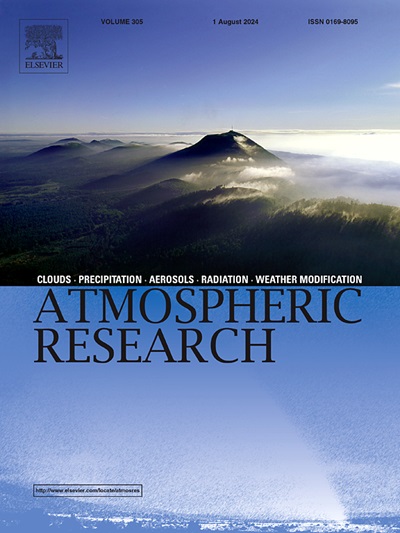Assessment of the origin of moisture for the precipitation of North Atlantic extratropical cyclones: Insights from downscaled ERA5
IF 4.5
2区 地球科学
Q1 METEOROLOGY & ATMOSPHERIC SCIENCES
引用次数: 0
Abstract
Extratropical cyclones (ECs) are large-scale synoptic weather systems characterised by complex mesoscale precipitation-generating features. Unresolved questions remain regarding how their water budget varies depending on the origin of the rainfall. This study aims to address this gap by examining the variability in moisture uptake patterns across EC precipitation structures. To achieve this, 237 cases were selected during the maximum deep phase over the North Atlantic (NATL). The study utilizes ERA5 downscaled simulations and Lagrangian moisture source diagnostics to identify key moisture parameters. We compare different precipitation-targeting approaches, including the radius, Warm Conveyor Belt (WCB) footprint, and square root spiral contours centred on the EC. The radius approach captures central precipitation and innermost rainbands, while the WCB target better represents the full extent. The NATL region was divided into sectors to facilitate a detailed analysis of geographic influences and dynamic factors, including moisture availability. Using the radius approach, moisture sources in the western/W and northern/N NATL are predominantly aligned along the Gulf Stream. When considering WCB and spiral targets, the 95th percentile moisture uptake pattern expands into the subtropics. Moisture patterns shift southward and intensify for broader targets. In NNATL ECs, the spiral region's moisture source shows peak uptake at ∼3000 km, exceeding the radial target's 1500 km. WNATL ECs exhibit intense moisture uptake, with a southwest (southeast) source extending up to 4500 (4000) km. In eastern/E NATL, EC-relative composites indicate evenly distributed moisture uptake, constrained within a 2000 km radius.

北大西洋温带气旋降水的水汽来源评估:来自缩小尺度ERA5的见解
温带气旋是具有复杂中尺度降水特征的大尺度天气系统。关于它们的水收支如何根据降雨的来源而变化的问题仍然没有解决。本研究旨在通过研究欧共体降水结构中水分吸收模式的可变性来解决这一差距。为了实现这一目标,在北大西洋(NATL)的最大深度阶段选择了237例病例。该研究利用ERA5缩尺模拟和拉格朗日湿源诊断来确定关键的水分参数。我们比较了不同的降水目标方法,包括半径、暖传送带(WCB)足迹和以EC为中心的平方根螺旋轮廓。半径方法捕获中心降水和最内层雨带,而WCB目标更好地代表了全部范围。为便于对地理影响和动态因素(包括水分供应)进行详细分析,将北海道区域划分为若干部门。利用半径方法,在西/W和北/N的水汽源主要沿墨西哥湾流排列。当考虑WCB和螺旋目标时,第95百分位的吸湿模式扩展到亚热带。水汽模式向南转移,范围更广。在NNATL ec中,螺旋区域的水汽源在~ 3000 km处显示出峰值吸收,超过了径向目标的1500 km。WNATL ec表现出强烈的水汽吸收,西南(东南)源延伸至4500(4000)公里。在东部/东部NATL, ec相对复合材料表明均匀分布的水分吸收,限制在2000公里半径内。
本文章由计算机程序翻译,如有差异,请以英文原文为准。
求助全文
约1分钟内获得全文
求助全文
来源期刊

Atmospheric Research
地学-气象与大气科学
CiteScore
9.40
自引率
10.90%
发文量
460
审稿时长
47 days
期刊介绍:
The journal publishes scientific papers (research papers, review articles, letters and notes) dealing with the part of the atmosphere where meteorological events occur. Attention is given to all processes extending from the earth surface to the tropopause, but special emphasis continues to be devoted to the physics of clouds, mesoscale meteorology and air pollution, i.e. atmospheric aerosols; microphysical processes; cloud dynamics and thermodynamics; numerical simulation, climatology, climate change and weather modification.
 求助内容:
求助内容: 应助结果提醒方式:
应助结果提醒方式:


